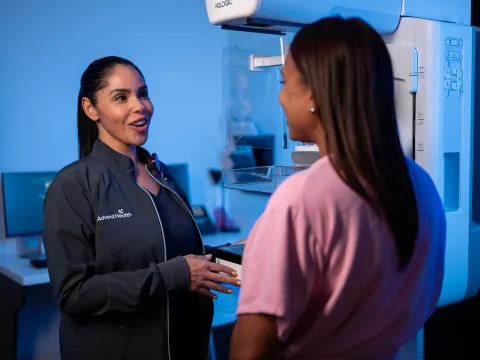- AdventHealth

Choose the health content that’s right for you, and get it delivered right in your inbox.
A mammogram is a powerful tool with its ability to catch breast cancer early. In fact, it can detect breast cancer up to two years before a tumor can be felt by you or your doctor.
Catching breast cancer early means:
- Therapies like breast conservation therapy will be most effective.
- Treatment can begin early, possibly before the cancer spreads to other parts of your body.
- You’ll have the best possible chance for a cure and full recovery.
Many women with breast cancer have no symptoms. According to the American Cancer Society, many decades of research show that women who have regular mammograms are more likely to have breast cancer found early, less likely to need aggressive treatment like surgery or chemotherapy and are more likely to be cured.
Screening vs. Diagnostic Mammograms
Mammography uses X-rays to take images of your breasts. Screening mammograms and diagnostic mammograms use the same equipment and procedures; they differ in the number and type of images made.
Screening mammograms are for women who are 40 years and older and have no signs of breast cancer such as a lump, pain or change in breast size or shape. Women who meet these qualifications do not need a script. These simple appointments are often complete in 30 minutes or less. Breast cancers found during screening exams are more likely to be smaller and still confined to the breast.
Diagnostic mammograms are prescribed when a screening mammogram shows an area of concern. They take more detailed images from different angles to help your care team make the most accurate diagnosis.
What Is 3D Mammography?
3D mammography (also called digital breast tomosynthesis or DBT) is an FDA-approved advancement to detect breast cancer early when it’s most treatable.
In a 3D mammogram, multiple thin-section images allow your radiologist to assess your breast tissue layer by layer. During the exam, the X-ray arm moves in a small arc over your breast and acquires several low-dose images, which are reconstructed into a 3D image. Conventional 2D mammograms obtain only two images of the breast.
About Your 3D Mammogram
Your health care provider may suggest a 3D mammogram to investigate an unexpected growth or to help identify the source of any symptoms you may have.
The American Society of Breast Surgeons recommends that all women over age 40 have an annual 3D mammography breast screening. Women with a higher-than-average risk of breast cancer should start screening earlier as recommended by your health care provider.
As 3D mammograms use many images of various layers of tissue, it makes it easier for your provider to detect unexpected growths even in dense breast tissue.
People with unusual symptoms or signs of breast disease may also need a 3D mammogram.
3D mammograms can also reduce the need for follow-up imaging.
Get Your 3D Mammogram at One of Our Imaging Centers
Don’t wait to schedule your mammogram. Early detection of breast cancer is so important because it’s still the second-leading cause of cancer deaths among American women.
We’re making it easy for you to get your annual screening mammogram at one of our five conveniently located Imaging Centers, part of our Care Pavilions that offer comprehensive care under one roof. With evening and weekend availability and our private mammogram suite, you’ll experience comfort and convenience.
Find a location closest to you and schedule your mammogram today. One simple screening might just save your life.




